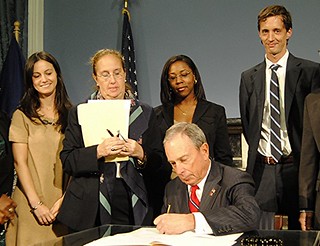The Road to a Win for New York City Youth
Mayor Michael Bloomberg recently signed 3 bills that will dramatically improve how New York’s disadvantaged youth connect to public assistance and educational programs. All three bills stem from a CSS report that uncovered tough obstacles faced by many low-income youth applying for help from the city’s Human Resource Administration (HRA). The CSS “Missed Opportunity” report drew wide support and spurred months of concerted advocacy that culminated in this major legislative win.

It all began with troubling accounts coming in from organizations CSS partners with through the Center for Benefits and Services (now The Benefits Plus Learning Center). In New York City, low-income youth ages 17-24 are eligible to apply for cash assistance if they are considered "independent." While some public assistance recipients are required to participate in work-related activities, regulations encourage or require HRA to place youth and others without a high school diploma in educational programs to fulfill their work requirement. Yet there were signs this was not happening.
CSS Director of Youth Policy Lazar Treschan explains: "We heard of young people being misled by HRA about their eligibility for public assistance, and placed in HRA's adult-focused Back to Work program, regardless of their age, education level, interests, or aspirations. That's when I got involved."
Lazar brought his concerns to David Jones, who immediately called for a research project to determine just how widespread the problem was. A rigorous, on-the-ground study, led by Lazar and conducted in partnership with the Resilience Advocacy Program (RAP), was soon underway. The study--funded by the Robert Sterling Clark and Ira W. DeCamp Foundations--involved youth focus groups and nearly 80 street interviews with youth outside HRA job centers. RAP's Brooke Richie-Babbage helped spearhead the project. The Campaign for Tomorrow's Workforce (CTW) joined the effort, along with CTW members Covenant House, The Door, and Opportunities for a Better Tomorrow. Says Lazar: "We asked young people, 'Did HRA talk with you about your goals?' 'Did they help you?'"
The stories poured in:
"When I met with an [HRA] worker, she asked me about what I wanted to do. I said, 'School, for my GED.' She said that was fine, but then she sent me to Back to Work (BTW).They made it seem like there was no other choice but BTW."
- Lashawn (age 18, without a HS diploma)
"At first, they told me that I needed to be 21 to get Public Assistance, even though I was homeless and living in a shelter with my child."
- Amanda (age 18)
In June 2011, David Jones announced the report, which revealed widespread divergence between HRA's stated policies and the day-to-day implementation of these policies. With him that day on the steps of City Hall were the City Council's General Welfare Committee led by Annabel Palma and with the strong support of Gail Brewer. Days later a NY Times editorial praised the findings. More packed hearings followed, with testimony from CSS, advocacy partners, and young people sharing their powerful stories. Nearly a year of tireless advocacy and negotiation led at last to the recently passed bills, which will help make sure that young people seeking public assistance can access it, and that the City is effectively connecting youth to the education programs and other services they need to escape poverty and fulfill their goals.